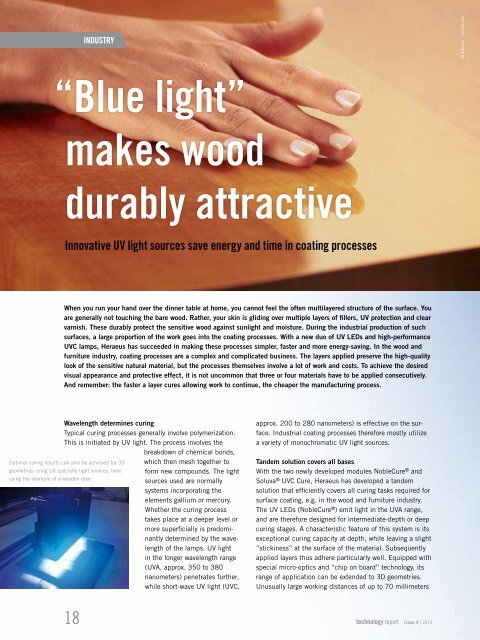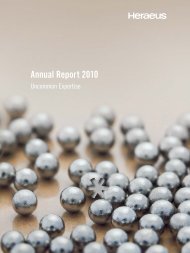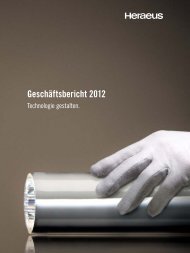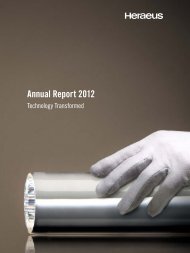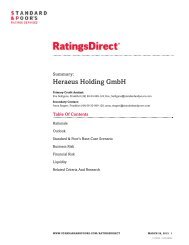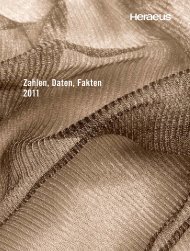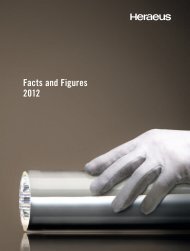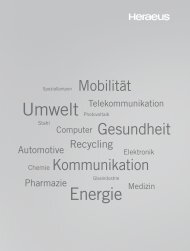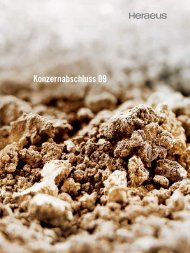technology report 04
technology report 04
technology report 04
You also want an ePaper? Increase the reach of your titles
YUMPU automatically turns print PDFs into web optimized ePapers that Google loves.
Industry<br />
© Visionär – Fotolia.com<br />
“Blue light”<br />
makes wood<br />
durably attractive<br />
Innovative UV light sources save energy and time in coating processes<br />
When you run your hand over the dinner table at home, you cannot feel the often multilayered structure of the surface. You<br />
are generally not touching the bare wood. Rather, your skin is gliding over multiple layers of fillers, UV protection and clear<br />
varnish. These durably protect the sensitive wood against sunlight and moisture. During the industrial production of such<br />
surfaces, a large proportion of the work goes into the coating processes. With a new duo of UV LEDs and high-performance<br />
UVC lamps, Heraeus has succeeded in making these processes simpler, faster and more energy-saving. In the wood and<br />
furniture industry, coating processes are a complex and complicated business. The layers applied preserve the high-quality<br />
look of the sensitive natural material, but the processes themselves involve a lot of work and costs. To achieve the desired<br />
visual appearance and protective effect, it is not uncommon that three or four materials have to be applied consecutively.<br />
And remember: the faster a layer cures allowing work to continue, the cheaper the manufacturing process.<br />
Wavelength determines curing<br />
Typical curing processes generally involve polymerization.<br />
This is initiated by UV light. The process involves the<br />
breakdown of chemical bonds,<br />
Optimal curing results can also be achieved for 3D which then mesh together to<br />
geometries using UV specialty light sources, here form new compounds. The light<br />
using the example of a wooden door.<br />
sources used are normally<br />
systems incorporating the<br />
elements gallium or mercury.<br />
Whether the curing process<br />
takes place at a deeper level or<br />
more superficially is predominantly<br />
determined by the wavelength<br />
of the lamps. UV light<br />
in the longer wavelength range<br />
(UVA, approx. 350 to 380<br />
nanometers) penetrates further,<br />
while short-wave UV light (UVC,<br />
approx. 200 to 280 nanometers) is effective on the surface.<br />
Industrial coating processes therefore mostly utilize<br />
a variety of monochromatic UV light sources.<br />
Tandem solution covers all bases<br />
With the two newly developed modules NobleCure ® and<br />
Soluva ® UVC Cure, Heraeus has developed a tandem<br />
solution that efficiently covers all curing tasks required for<br />
surface coating, e.g. in the wood and furniture industry.<br />
The UV LEDs (NobleCure ® ) emit light in the UVA range,<br />
and are therefore designed for intermediate-depth or deep<br />
curing stages. A characteristic feature of this system is its<br />
exceptional curing capacity at depth, while leaving a slight<br />
“stickiness” at the surface of the material. Subsequently<br />
applied layers thus adhere particularly well. Equipped with<br />
special micro-optics and “chip on board” <strong>technology</strong>, its<br />
range of application can be extended to 3D geometries.<br />
Unusually large working distances of up to 70 millimeters<br />
18<br />
<strong>technology</strong> <strong>report</strong> Issue 4 | 2013


